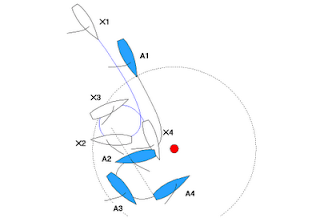By Brass from “The Room”
Introduction
We are about half way through the Fact Finding Friday program, so it's a good time to have a review.
Please respond and take the opportunity to discuss any of the things covered here, or any things you think have been missed out, so we can all develop and learn from our experiences.
Me Fundamental Goals and Our Development
I am not the Rules God: I don't get to tell people what they can and cannot do. All I do is make suggestions, and explain my reasons. Hopefully, looking at the suggestions and the good and not so good solutions submitted by others, each of us can improve and develop effective writing habits.
Whatever you may read or think, you should always do what your Chief Judge, protest committee chair or MNA directs you to do.
Fundamental criteria is that a decision should be ABC: Accurate, Brief and Complete. I think we would all agree that Accurate is a Fundamental Rule, but maybe there is a little 'wriggle-room' between Brief and Complete.
We have also discussed speed. In a busy protest committee we may need to be producing written decisions in about 20 to 30 minutes, or faster if possible. One of the primary purposes of FF Friday is to provide opportunities to improve our speed.
Evidence, Facts and Conclusions
We have discussed the dividing line between facts and conclusions and the progression from evidence to facts. The following references might be helpful
Facts include things which are inferred or deduced from other evidence or facts, and may include the intentions or other mental states of people, where this is relevant and proved by evidence.
Conclusions are what you decide by applying the rules to the facts.
Style
Style Guides
The purpose of style guides and discussion such as in FF Friday, is to
Simple style guides or standards help us to write decisions Accurately, Briefly, Completely and Quickly, with consistency.
Although I am not an American, I find the US Sailing Appeals Style Manual very useful as a guide to consistent style. If you are a US Sailing Judge, you may be obliged to follow this style guidance. If you do not like a specific rule in the US Sailing Manual, at least it indicates an area where it may be useful to develop and adopt a consistent style of your own.
Facts Found
I am a great fan of short, numbered paragraphs for facts found. One fact per paragraph. I know that the example decisions from the Olympics, World Champs and so on, usually run facts together in a single paragraph. This looks shorter, and fits nicely on forms and XML databases, but separate paragraphs are easier to follow (and to refer to in an appeal). They take up more space but no more words.
Conclusions
I have a very strong belief in using the words and grammar of the rules, as exactly as possible. I think this helps us remember the rules, and avoid confusion with previous versions. Thus there is 'contact' between boats, not 'collision', boats 'become overlapped', a boat does not 'establish an overlap', boats 'break' rules, they do not 'infringe' them, and so on.
Those of us working on the Protest Conclusion Wording project have agreed hat a conclusion should state the act that constitutes breaking the rule, using, as far as possible, the words of the rule, no more, no less. The Protest Conclusion Wording tool will help you get the exact wording needed for the appropriate conclusions for any of the rules.
The provisional version of the tool is on LTW at:
Protest Decision Wordings V7 (2009) provisional.xls
Background is discussed on LTW at:
Protest Conclusions and Decision Wording 2009
The tool is intended to time and effort. Sometimes the suggested wordings are a little more lengthy than you could come up with on your own, but by using them, you increase your chances of not missing steps in the logical chain.
I also think that, whenever a conclusion is about a boat breaking a rule, the conclusion should include express words such as 'X broke rule RR'. This leaves nobody in any doubt that the protest committee is going to act in accordance with rule 64.1(a). Other people might just bracket the rule after the conclusion. Still others might not to put the relevant rule in each conclusion, but to just list all the relevant rules at the end of the Conclusions: I think that this makes it unnecessarily difficult for readers to relate the conclusions to the rules.
We should usually omit 'rules discussion' and intermediate conclusions.
We should make conclusions about all rules that are broken, then make exoneration or non-penalization conclusions. We should not just skip over a rule because we know a boat will be exonerated or protected from penalty.
The Upside Down Test
Finally, you might like to use the 'Upside Down Test'. The test of a good written decision is to be able to turn the written decision upside down and write a well formed, logical paragraph, beginning:
'X is disqualified because [Conclusion] because [fact(s)]'.
This should highlight any Facts or Conclusions that are irrelevant or superfluous, and, perhaps more importantly, show up any inadequacies in facts found.
Summing Up
Accurate, Brief, Complete, and Quick – requires practice.
Please contribute to discussion about this post.






























 Small change can often be found under seat cushions
Small change can often be found under seat cushions